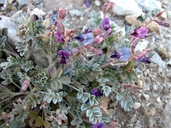Taxon Report
Astragalus albens GreeneCushenbury milk-vetch |
 © 2011 Gina Richmond |
Taxon Summary
Astragalus albens, commonly known as Cushenbury milk-vetch, is a perennial herb in the Fabaceae that is found only in California. It occurs within Joshua tree "woodland", Mojavean desert scrub, and Pinyon and juniper woodland, growing at elevations from 1095 to 2000 meters. Astragalus albens is ranked 1B.1, Plants Rare, Threatened or Endangered in California and Elsewhere; Seriously threatened in California.Classification
|
Scientific Name: |
Astragalus albens Greene |
|
Common Name: |
Cushenbury milk-vetch |
| Family: | Fabaceae |
| Element Code: | PDFAB0F0A0 |
| USDA Plants Symbol: | ASAL4 |
|
Synonyms/Other Names: |
|
Ecology and Life History
| Lifeform: | perennial herb |
| Blooming Period: Mar-Jun | Mar-Jun |
| Elevation: | 1095-2000 (3595-6560) |
| General Habitats: | Joshua tree "woodland", Mojavean desert scrub, Pinyon and juniper woodland |
| Microhabitat: | Carbonate (usually), Granitic (rarely) |
| Microhabitat Details: |
Conservation Status
| CA Rare Plant Rank: | 1B.1 |
| Global Rank: | G1 |
|
State Rank: |
S1 |
| State List: | None |
| Fed List: | FE |
| Other Status: | SB_CalBG/RSABG |
|
CRPR Changes: |
|
Occurrence Data from the CNDDB
| Total Occurrences: | 23 |
| Element Occurrence Ranks: | |
| Excellent (A) | 2 |
| Good (B) | 9 |
| Fair (C) | 5 |
| Poor (D) | 0 |
| None (X) | 0 |
| Unknown (U) | 7 |
| California Endemic: True | |
| California Counties and Islands: Name (Code) | |
| San Bernardino (SBD) | |
| Quads: Name (Quad Code) | |
| Big Bear City (3411637), Cougar Buttes (3411647), Fawnskin (3411638), Rattlesnake Canyon (3411636) | |
Threat List Data from the CNDDB
| Threat List Total: | 9 | |
| EOs with Threat Listed: | Total EOs | % of EOs |
| 18 | 78 % | |
| Mining | 14 | 60% |
| ORV activity | 9 | 39% |
| Road/trail construction/maint. | 7 | 30% |
| Vandalism/dumping/litter | 3 | 13% |
| Foot traffic/trampling | 2 | 8% |
| Grazing | 2 | 8% |
| Other | 2 | 8% |
| Recreational use (non-ORV) | 2 | 8% |
| Development | 1 | 4% |
Selected References
| Fremontia 16(1):20-21 (1988) for discussion of mining threats |
Citation
California Native Plant Society, Rare Plant Program. 2025. Rare Plant Inventory (online edition, v9.5.1). Website https://www.rareplants.cnps.org [accessed 14 December 2025].